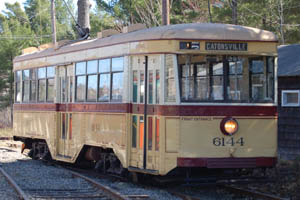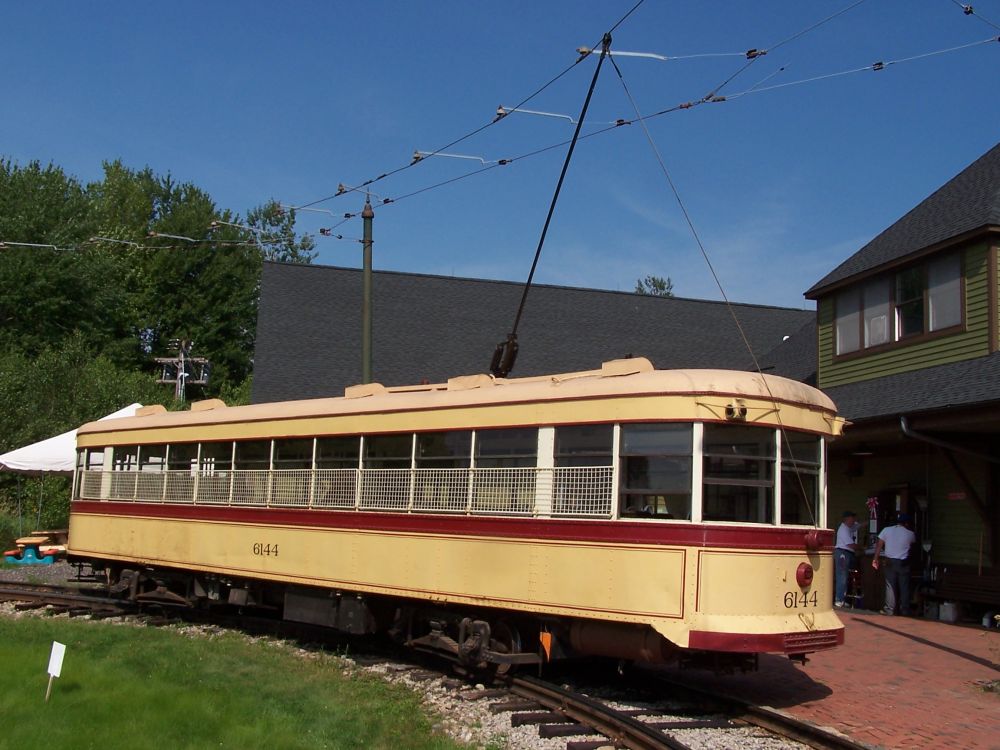
- Builder
- J. G. Brill Co.
- Description
- Peter Witt
- Secondary Use
- None
- Type
- City and Suburban Streetcars
- Year
- 1930
- Retired from Service
- 1955
- Acquired by the Museum
- 1955
- Note
- As of April, 2017, No. 6144 was stored at the Highwood carbarn.
- Fund
- 523
Baltimore Transit Co. 6144
From Baltimore, Maryland
History
In the early 1920s, Baltimore’s United Railways and Electric operated nearly 2000 cars over more than 400 miles of track, one of the largest street railway systems in the U.S. Baltimore’s track gauge, 5 ft. 4 ½ in., was the widest in the industry. The company reorganized as Baltimore Transit Co. in 1935. The BTC converted most of its lines to buses between 1948 and 1956. Its last streetcar ran in 1963.
“Peter Witt” streetcars were designed by Cleveland Transit Commissioner, Peter Witt in 1914, and featured center doors. The center door was for exiting and a front door was for passenger entrance. The conductor was stationed before the center door. Passengers would pay their fare as they passed the conductor which reduced dwell time at stops. This “Peter Witt” style car, manufactured by several builders, became popular in Cleveland and elsewhere.
United Railways and Electric purchased 150 Peter Witt cars. The last 50, Nos. 6101 to 6150, came from Brill in 1930 and featured mechanical advancements including a Westinghouse Variable Automatic control system and some cars (including No. 6144) were equipped with a W-N double reduction gear system. These cars were precursors of the streamlined PCC streetcar design a few years later. The mechanical improvements allowed smoother acceleration and faster schedules. Payments for these Peter Witt cars helped drive UR&E into bankruptcy in 1933.
Baltimore Transit donated No. 6144 to Seashore in 1955. No. 6144 was joined by Baltimore Transit No. 5748, a Brill semi-convertible car which Seashore acquired in 1957. These are two of only three Baltimore streetcars preserved outside of Baltimore. The third is the body of a 1920 Birney located at Union College in Lincoln, NE. Seashore built a short section of 5 ft. 4 ½ in. gauge track and was able to run No. 6144 when it came to Maine. In the 1970s, Seashore volunteers rebuilt the trucks to standard gauge at the same time as Philadelphia & West Chester No. 62. The broad gauge axles from No. 62 were machined down to become No. 6144’s standard gauge axles. No. 6144 has unusual traction motors, which feature a cylindrical steel main body with aluminum end caps. As steel and aluminum tend to deteriorate from a process known as electrolysis when touching, Seashore’s shop found it impossible to separate the end caps so the motors could be serviced. The motors were subsequently overhauled by the MBTA as part of the arrangement for Seashore’s lease of Claremont Ry. line car No. 4 to the MBTA in the 1970s. However, the MBTA also had difficulty disassembling the motors, and one of the aluminum end caps shattered. Fortunately, Ben Minnich had spotted two spare motors as he drove No. 6144 out of the Baltimore carbarn in 1955 and arranged to have them loaded onto his rig. One of these was successfully overhauled by the MBTA and allowed the car to become operable.
Technical Information
- Seats: 52
- Control: VA (29A5)
- Brakes: SME (M33)
- Compressor: DH-25
Trucks
- Number: 2
- Manufacturer: Brill
- Model: 177E-1X
Motor
- Number: 4
- Manufacturer: Westinghouse
- Model: 1422
Weight and Dimensions
- Length: 45’ 11.00"
- Width: 8’ 9.00"
- Height: 11’ 4.00"
- Weight: 38500 lbs.
Additional Images

Phil Morse on 07/31/06

Fred Maloney Collection
© 1998 - 2025 New England Electric Railway Historical Society. All Rights Reserved.